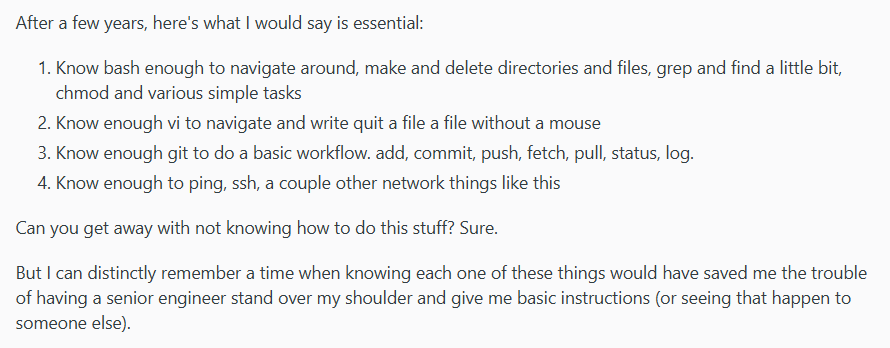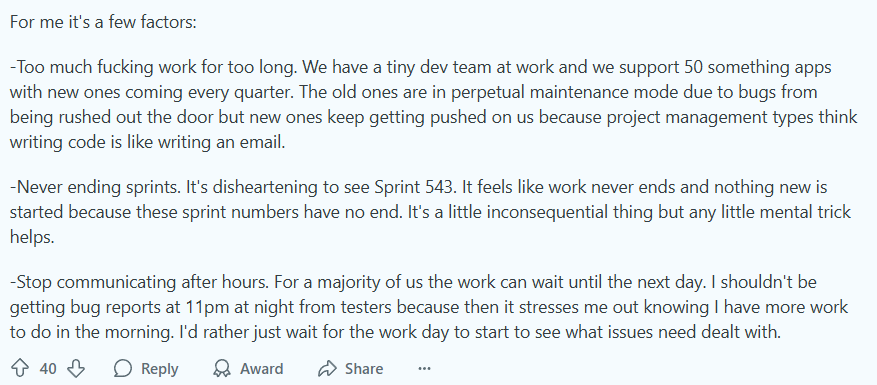In this article
You’re paying developers to build features, but track their time for a week and you’ll probably find something depressing.
Most are lucky to get 2-3 hours of actual coding time between standup meetings, Slack notifications, and waiting for someone to approve their pull request.
The rest is death by a thousand small inefficiencies. Five minutes to restart flaky tests, ten minutes to fix staging, and twenty minutes to get deploy approvals.
Developers are actively discussing this problem. As one Reddit developer pointed out:

(Source)
But most of these productivity killers are completely fixable. And no, you don’t need to burn everything down and start over.
Below, we’ll share 16 actionable tips that engineering leaders can use to target these specific problems and give their team their time back.
1. Master Your Integrated Development Environment (IDE)
1. Master Your Integrated Development Environment (IDE)
Why it matters: Your IDE is where developers spend 80% of their coding time, yet most teams treat it like any other text editor. A well-configured development environment can save 15-30 minutes per developer per day through faster navigation, automated tasks, and reduced context switching.
The frustration comes when basic setup becomes a barrier to productivity, as one developer on Reddit recently expressed:

(Source)
How to implement:
- Share IDE configurations across your team: Set up shared config files and extension lists so everyone has the same development environment and new hires can get up to speed quickly.
- Set up consistent code formatting and linting: Use tools like Prettier, ESLint, or Black to automatically format code on save and catch errors before they hit version control.
- Train your team on advanced IDE features: Run regular sessions to teach keyboard shortcuts, code templates, debugging tools, and built-in version control that most developers don’t use.
- Let developers customize within guidelines: Allow personal touches while you maintain team standards for key extensions and code formatting rules.
Common mistakes ⚠️: Most teams set up their IDE once and forget about it. Developers stick with default settings or basic configurations, and miss powerful features that could save them hours every week.
PRO TIP 💡: Use Jellyfish’s developer experience surveys to track how much time your team spends on environment setup and tooling issues. You can see which developers are losing the most time to configuration problems and prioritize IDE improvements that will have the biggest impact.
2. Learn the Command Line Interface (CLI)
2. Learn the Command Line Interface (CLI)
Why it matters: CLI mastery separates productive developers from those who constantly click through menus and wait for GUIs to load. Engineering operations that take place in a graphical interface often need just one command, and developers who know their terminal can automate tasks and troubleshoot issues much faster.
A senior developer recently shared what they consider the bare minimum CLI skills every developer should have:

(Source)
How to implement:
- Start with essential commands: Teach your team the core file operations, text manipulation, and process management commands they’ll use daily.
- Create team-specific aliases and scripts: Build shortcuts for common project tasks like running tests, deploying code, or setting up work environments.
- Encourage incremental learning: Have developers learn one new command each week rather than trying to master everything at once.
- Share useful one-liners in team channels: Create a culture where programmers share helpful CLI tricks and shortcuts they discover.
Common mistakes ⚠️: Teams often assume that GUI tools are always more user-friendly and skip CLI training entirely. Or, developers sometimes try to learn too many commands at once and get overwhelmed, then abandon CLI learning altogether.
3. Automate Repetitive Tasks
3. Automate Repetitive Tasks
Why it matters: If your developers are manually running the same sequence of commands more than twice, they’re wasting time that compounds daily. Automation turns 10-minute manual processes into 30-second scripts and frees up mental energy for actual problem-solving instead of routine maintenance.
This developer captures the essence of why automation should be a priority:

(Source)
How to implement:
- Outline the most frequent manual tasks: Track what your team does repeatedly each day, from running tests to deploying code to setting up new environments.
- Start with simple scripts: Begin with basic shell scripts or task runners that handle common operations like codebase setup, file generation, or environment configuration.
- Use build tools and task runners: Implement tools like Make, npm scripts, or language-specific task runners to standardize how your team runs common operations.
- Create development workflow automation: Set up automated formatting, linting, and testing that run before commits or during pull requests.
Common mistakes ⚠️: Teams often tolerate repetitive manual processes because “it only takes a few minutes,” without calculating the cumulative time cost across the entire team. Another mistake is creating overly complex automation that’s harder to maintain than the original manual process, or building scripts that only one person understands.
PRO TIP 💡: You can prove the ROI of your automation investments with Jellyfish’s workflow analytics. The platform shows you exactly how much time your scripts are saving and outlines the manual tasks that are still eating up developer hours.
4. Invest in the Right Tools
4. Invest in the Right Tools
Why it matters: Clunky project management software, messy CI pipelines, and outdated editors bring friction to even the simplest tasks. A good tool saves each developer 10-15 minutes daily, while a bad tool costs them that much time in friction and frustration.
One Reddit comment summed up the real cost of skimping on developer tools:

(Source)
How to implement:
- Involve developers in tool selection: Let the people who use the tools have input on decisions rather than making purchases based solely on management preferences.
- Prioritize integration over individual features: Choose tools that work well together and share data seamlessly rather than best-in-class tools that don’t connect.
- Start with pilot programs: Test new tools with a small group before rolling them out to the entire team to avoid costly mistakes.
- Standardize on a core set of team productivity tools: Set up team-wide standards for code editors, terminal applications, and communication tools to reduce support overhead.
Common mistakes ⚠️: Teams often choose tools based on hype or feature comparisons rather than how well they fit into existing workflows. Another frequent mistake is being penny-wise and pound-foolish — teams refuse to pay for better tools while they pay high salaries for developers who get frustrated by slow, limited software.
PRO TIP 💡: Jellyfish integrates with 50+ development tools to show you which ones actually speed up your team versus those creating expensive overhead. You can finally make tool decisions based on impact, not sales pitches.
5. Leverage Generative AI Tools
5. Leverage Generative AI Tools
Why it matters: Generative AI tools can handle routine work like boilerplate code, standard functions, and code explanations, so your developers can focus on the interesting problems. They’re especially powerful for junior developers who suddenly have access to senior-level code recommendations and can learn faster than ever before.
This Reddit user described exactly how AI coding tools can help overcome common software development roadblocks:

(Source)
How to implement:
- Train your team on effective AI prompting: Teach developers how to write clear, specific prompts that produce better code suggestions.
- Begin with AI-powered code completion and generation: Tools like GitHub Copilot, Claude, or ChatGPT can write boilerplate code, generate test cases, and propose implementations based on comments or function signatures.
- Set up guidelines for AI-generated code: Create standards for reviewing, testing, and documenting code that AI tools produce to maintain quality.
- Start with low-risk tasks: Begin with AI assistance for unit tests, code comments, and simple functions before moving to more complex implementations.
Common mistakes ⚠️: The biggest mistake is treating AI like a replacement for developers instead of a productivity tool. You should use AI for repetitive tasks, so developers can tackle hard problems that require human judgment.
6. Plan Thoroughly Before Coding
6. Plan Thoroughly Before Coding
Why it matters: Jumping straight into code without proper planning is one of the fastest ways to waste development time. Good planning helps developers think through problems systematically, anticipate issues, and choose the right approach from the start.
This developer explained exactly why “just start coding” can be expensive thinking:

(Source)
How to implement:
- Create detailed technical specifications: Write clear specs that outline requirements, constraints, and expected outcomes before any code gets written.
- Use design documents for complex features: Have developers create architecture diagrams and implementation plans for anything that will take more than a few days to build.
- Break large tasks into smaller, testable pieces: Break down big features into small, manageable chunks that you can complete and verify independently.
- Discuss your approach with teammates beforehand: A quick design review can spot architectural issues and propose better approaches before you’ve written hundreds of lines of code.
Common mistakes ⚠️: Many teams rush into coding because planning feels like it slows things down, but this almost always backfires with more rework later. Also, developers sometimes create overly detailed plans that become outdated quickly, or spend too much time on planning documents that no one will read.
PRO TIP 💡: Use Jellyfish’s cycle time analysis to see how much rework and debugging time you can avoid when you plan better upfront. The platform tracks how often you revert code or make big changes, so you can see the real cost of skipping the planning phase.
7. Adopt Agile Development Methods
7. Adopt Agile Development Methods
Why it matters: Agile methods help teams deliver working software faster and respond to changes better than traditional approaches. They also create predictable rhythms that help developers focus on immediate goals instead of getting overwhelmed by massive project timelines.
The challenge with agile is that it can easily backfire if you focus on the wrong things. A developer on Reddit explained what happens:

(Source)
How to implement:
- Get user feedback early and often: Release beta versions, run user tests, and get real usage data before you invest heavily in features that might miss the mark.
- Use time-boxed cycles to maintain momentum: Set fixed periods for work that force decisions and prevent endless perfectionism on individual features.
- Keep your backlog clean: Organize, prioritize, and update your feature list so developers always know what to work on next.
- Run focused daily standups: Keep meetings about progress, blockers, and next steps rather than detailed status reports.
Common mistakes ⚠️: Many teams set up agile ceremonies without embracing agile principles, which only leads to “agile theater” where you have daily standups but still work alone for weeks at a time.
8. Implement Continuous Integration & Continuous Delivery (CI/CD)
8. Implement Continuous Integration & Continuous Delivery (CI/CD)
Why it matters: Manual deployments and testing create bottlenecks that slow down your entire development cycle at the worst possible moments. A solid CI/CD pipeline spots bugs before they reach production, automates the tedious parts of releases, and gives your team confidence to deploy changes more frequently.
If you’re still not convinced about the value of CI/CD, here’s a clear breakdown of why these pipelines matter:

(Source)
How to implement:
- Set up automated testing that runs on every commit: Configure unit tests, integration tests, and linting checks to catch issues immediately.
- Automate your deployment process completely: Remove manual steps, approval chains, and “deployment Fridays” with scripts that can safely deploy code with a single command.
- Create staging environments that mirror production: Test deployments in environments that closely match your live methodology to catch configuration and environment-specific issues.
- Monitor new deployments closely: Set up alerts and dashboards to spot issues quickly when new code goes live.
Common mistakes ⚠️: Teams often build overly complex CI/CD pipelines that take longer to run than manual processes, defeating the purpose of automation. Another mistake is treating CI/CD as a deployment tool only, when the real value comes from the feedback loop that catches problems early and builds confidence in your release process.
9. Optimize Your Software Delivery Pipeline
9. Optimize Your Software Delivery Pipeline
Why it matters: When developers have to wait hours for builds to complete or days for code to move through environments, they lose momentum on their work. Fast, reliable pipelines keep developers in deep work and support quick changes to features.
How to implement:
- Find and remove manual approval gates: Review your process for unnecessary human checkpoints that bring delays, especially for low-risk changes.
- Parallelize builds and tests: Run independent tasks at the same time instead of processing everything sequentially.
- Implement smart deployment strategies: Use blue-green deployments, canary releases, or rolling updates to reduce downtime.
- Use infrastructure as code: Manage your environments with version-controlled scripts so you can spin up consistent infrastructure quickly.
Common mistakes ⚠️: One major mistake is accepting slow test suites as “just how it is” rather than investing time to make them faster and more reliable. Some teams also frequently add more steps to the pipeline without deleting outdated ones, and then have to deal with unnecessarily complex processes.
10. Improve Communication and Collaboration
10. Improve Communication and Collaboration
Why it matters: Poor communication often creates more delays than technical problems do, but teams often treat it as a “soft skill” instead of a productivity issue. When developers don’t know what their teammates are working on, they duplicate work and make decisions without the right input.
A recent Dev.to post nailed why communication is no longer optional for developers:

(Source)
How to implement:
- Set up clear communication channels: Create specific channels for different types of discussions so important initiative information doesn’t get in the general Slack thread.
- Create shared documentation that stays current: Maintain wikis, README files, and decision logs that new team members can use to get up to speed without asking the same questions repeatedly.
- Implement structured code review processes: Set clear expectations for review timelines, feedback quality, and approval criteria so code doesn’t sit in limbo waiting for input.
- Hold focused meetings with clear agendas: Limit meetings to decisions that demand real-time discussion and send actionable summaries afterward so participants know what to do next.
Common mistakes ⚠️: Teams often create too many communication channels that fragment conversations and make information hard to find. Or, they default to meetings for everything instead of using async communication for tasks that don’t need immediate discussion.
PRO TIP 💡: You can monitor meeting overload and context switching with Jellyfish’s calendar integration and work pattern analysis. The platform shows which developers are losing focus time to excessive meetings and helps you protect productive coding blocks.
11. Set Realistic Deadlines
11. Set Realistic Deadlines
Why it matters: When developers constantly work under impossible time pressure, they cut corners, skip testing, and accumulate technical debt that slows down future development. Teams that consistently miss deadlines lose trust with stakeholders and create a culture of stress and burnout.
This developer explained why sustainable sprint pacing matters more than constant urgency:

(Source)
How to implement:
- Include buffer time for unexpected issues: Add 20-30% extra time to estimates to account for bugs, scope changes, and other surprises that always come up.
- Break large projects into smaller milestones: Create intermediate deadlines that allow for course corrections and give stakeholders insight into progress.
- Base estimates on historical data: Track how long similar tasks took in the past, so you don’t just rely on optimistic guesses.
- Communicate trade-offs clearly: Explain what features or high-quality standards need to change if deadlines can’t move.
Common mistakes ⚠️: Many leaders treat deadlines as motivation tools rather than planning tools, so they set artificially tight timelines to “push the team” without considering the long-term cost of rushed code.
12. Prioritize Work-Life Balance
12. Prioritize Work-Life Balance
Why it matters: Burned-out developers are unproductive developers who make more mistakes and solve problems slower. When your team consistently works long hours, their creativity drops, their code quality suffers, and they start looking for new jobs.
This developer on Reddit made a point that engineering leaders should take seriously about boundary setting:

(Source)
How to implement:
- Set clear boundaries around work hours: Define when developers should be available and respect their time outside those hours.
- Discourage after-hours work: Lead by example and avoid sending non-urgent messages or scheduling meetings outside normal business hours.
- Offer flexible work arrangements: Let developers work from home, adjust their schedules, or take breaks when they need them.
- Encourage time off: Make sure developers actually take their vacation days and don’t feel guilty about being away from work. Prove that you care for their well-being.
Common mistakes ⚠️: Many teams pay lip service to work-life balance but still reward the developers who work nights and weekends, which sends mixed messages about what’s valued. Teams then create cultures where taking breaks is seen as a lack of commitment.
PRO TIP 💡: Jellyfish tracks after-hours activity and workload distribution to spot developers who are heading toward burnout before it impacts their productivity. You can see who’s consistently working late and rebalance workloads before you lose good people.
13. Practice Focused Learning and Skill Development
13. Practice Focused Learning and Skill Development
Why it matters: The best developers are always learning, and if you don’t give them opportunities to grow, they’ll find a company that will. Plus, teams that invest in skill development attract and keep top talent who could easily work anywhere else.
The secret to continuous growth shouldn’t be complicated, as this developer explains:

(Source)
How to implement:
- Create dedicated learning time during work hours: Set aside regular time for developers to learn new technologies, practice skills, or explore tools that could benefit the team’s projects.
- Focus on fundamentals over trendy frameworks: Invest in deep knowledge of core concepts like algorithms, system design, and software architecture that apply across technologies.
- Set up knowledge sharing sessions: Ask team members to present what they’ve learned, demo new tools, or explain complex concepts to spread knowledge across the entire team.
- Support conference attendance and courses: Invest in external learning opportunities that expose your team to industry best practices and new ideas.
Common mistakes ⚠️: Teams often treat learning as something that happens outside of work hours. This only leads to inconsistent skill development and burnout from developers trying to keep up on their own time.
14. Actively Combat Burnout
14. Actively Combat Burnout
Why it matters: According to a Haystack study, 83% of developers suffer from burnout. And by the time you notice the symptoms (e.g., missed deadlines or disengaged developers), you’re already dealing with productivity issues and potential turnover that costs far more than prevention would have.
A developer recently shared what’s driving their burnout, and it’s a perfect checklist of what not to do:

(Source)
How to implement:
- Rotate high-stress responsibilities: Share difficult tasks like on-call duties, customer escalations, and legacy system maintenance across the team.
- Tackle workload imbalances quickly: Redistribute work when someone is consistently working more hours or handling more complex problems than their teammates.
- Create psychological safety: Make sure developers feel comfortable saying no to unrealistic requests and asking for help when they need it.
- Encourage regular breaks and time off: Normalize taking lunch breaks, going for walks, and using vacation days without guilt or pushback.
Common mistakes ⚠️: Many leaders wait until developers are already burned out before they take action, when prevention is much easier than recovery. Teams also often focus on surface-level perks like snacks or ping pong tables rather than fixing the underlying work conditions that actually cause burnout, like broken processes or impossible deadlines.
15. Match Developer Strengths with Projects
15. Match Developer Strengths with Projects
Why it matters: Developers perform best when they work on projects that match their skills and interests. When you assign someone to work on something they’re passionate about, they move faster, write better code, and feel more motivated.
How to implement:
- Learn each developer’s preferences and strengths: Have regular conversations about what types of work energize people and what they want to avoid.
- Create skill matrices for your team: Map out who’s strong in which technologies, domains, and types of problems to make better assignment decisions.
- Balance growth opportunities with increased productivity: Give developers some challenging work outside their comfort zone, but don’t make every project a struggle.
- Let developers volunteer for interesting projects: When possible, let people choose what they want to work on rather than just assigning tasks.
Common mistakes ⚠️: Many teams assign work based purely on availability or assume all developers are interchangeable. Another mistake is always giving the most interesting work to senior developers while junior developers get stuck with tedious maintenance tasks.
PRO TIP 💡: Jellyfish’s contributor insights show you each team member’s productivity patterns and optimal project types, so you can make assignments that maximize both speed and job satisfaction.
16. Maximize the Use of Open-Source Software
16. Maximize the Use of Open-Source Software
Why it matters: Open-source libraries let your developers focus on your specific business problems instead of rebuilding common features like user authentication or data processing. Teams that use open-source well ship faster because they can build on work that other developers have already tested and refined.
This advice also shows how open-source contributions can develop skills that benefit your internal projects:

(Source)
How to implement:
- Define criteria for evaluating open-source projects: Look at factors like community size, maintenance activity, documentation quality, and security track record.
- Create a process for adding new dependencies: Review licensing, security implications, and long-term maintenance before you add libraries to your project.
- Contribute back to projects you use: Report bugs, submit patches, or improve documentation for tools that benefit your team.
- Stay current with security updates: Monitor your dependencies for vulnerabilities and update them regularly to avoid security risks.
Common mistakes ⚠️: Teams often either avoid open-source entirely out of security concerns or adopt every new library without considering long-term maintenance costs. Another mistake is choosing trendy but immature projects over boring but reliable solutions.
Leverage Jellyfish to See What's Really Killing Your Developer Productivity (And Fix It)
Leverage Jellyfish to See What’s Really Killing Your Developer Productivity (And Fix It)
Jellyfish is a powerful software engineering intelligence platform that integrates with your current tools like GitHub, Jira, and Slack to pinpoint exactly what’s eating up your developers’ time.
The platform reveals what’s really going on behind the scenes of your development process without adding any overhead for your team.
Here’s exactly what Jellyfish brings to the table:
- Get DORA productivity metrics without the setup headache: Jellyfish automatically tracks deployment frequency, lead time, change failure rate, and mean time to recovery straight from your existing CI/CD and incident management tools, so you can benchmark your team’s performance without custom dashboards.
- Identify which tips will actually impact your engineering team: Track cycle times, deployment frequency, and where work gets stuck, so you know whether to fix your CI pipeline or your code review process first.
- Track the ROI of your productivity investments: See whether that expensive new CI system or project management tool actually made your team faster or just bloated your tech stack.
- See where engineering effort really goes: Get a clear breakdown of how much effort goes to planned features versus fixing bugs, handling support requests, and paying down technical debt.
- Stop making promises your team can’t keep: Build realistic project timelines using actual historical velocity data, so you can hit deadlines without forcing your team into crunch mode.
- End the “are we there yet?” meetings forever: Replace those weekly status meetings where everyone asks why things are taking so long with concrete data showing exactly what’s blocking progress, how much capacity your team actually has, and what trade-offs need to be made.
Book a demo and discover what’s really happening with your developers, your deadlines, and your engineering investments.
FAQs
FAQs
How do you accurately measure developer productivity?
Measure developer productivity through outcomes and flow, not activity.
Track how long features take from start to finish, how often you deploy, and how quickly you recover from failures. Then, use developer satisfaction surveys and team feedback to complete the picture.
Don’t measure individual output like lines of code or commits. Developers will game these KPIs and won’t focus on delivering valuable software.
With 16 tips in this article, where is the best place to start?
Start with your development team environment and tooling. Fix slow CI pipelines, broken local setups, and time-consuming deployment processes.
These changes give instant relief to your entire team and create momentum for bigger improvements.
What is the most common mistake leaders make when addressing productivity?
Many leaders focus too much on measuring individual output instead of fixing the broken processes and tools that slow everyone down. They try to squeeze more work out of people rather than making the work itself easier.
How should we balance investing in new tools versus improving our processes?
Fix your processes first because new tools won’t solve problems caused by poor communication or broken workflows. Once your processes work smoothly, invest in tools that make good processes faster.
Learn More About Developer Productivity
Learn More About Developer Productivity
- What is Developer Productivity & How to Measure it the Right Way
- What is Developer Productivity Engineering (DPE)?
- 9 Common Pain Points That Kill Developer Productivity
- Automation in Software Development: The Engineering Leader’s Playbook
- 29 Best Developer Productivity Tools to Try Right Now
- 21 Developer Productivity Metrics Team Leaders Should Be Tracking
- AI for Developer Productivity: A Practical Implementation Guide
- How to Build a Developer Productivity Dashboard: Metrics, Examples & Best Practices
- Developer Burnout: Causes, Warning Signs, and Ways to Prevent It
- 10 Peer Code Review Best Practices That Turn Good Developers Into Great Ones
- Mitigating Context Switching in Software Development
About the author

Lauren is Senior Product Marketing Director at Jellyfish where she works closely with the product team to bring software engineering intelligence solutions to market. Prior to Jellyfish, Lauren served as Director of Product Marketing at Pluralsight.




